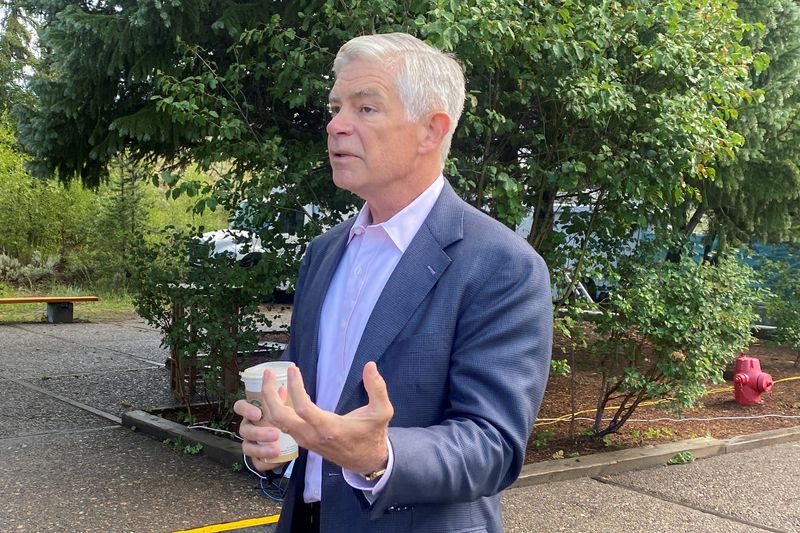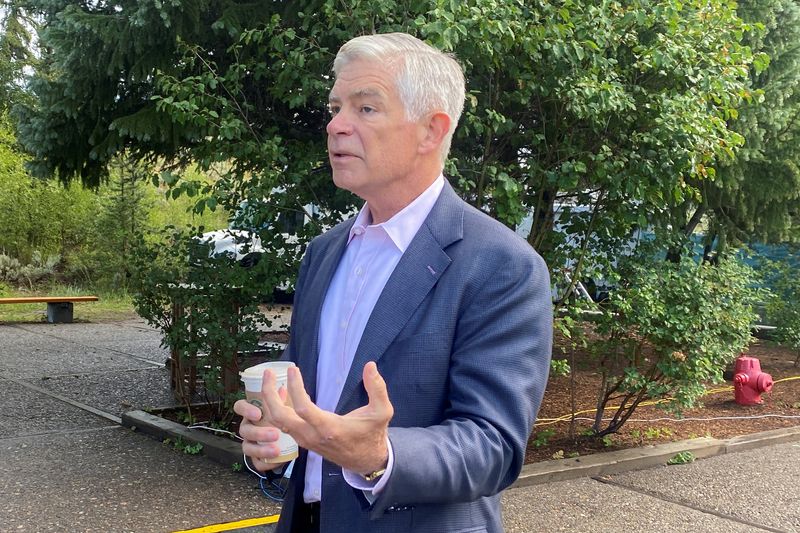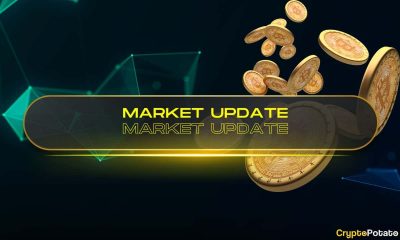Economy
Fed may be at point to ‘hold rates steady,’ Harker says


© Reuters. FILE PHOTO: Philadelphia Federal Reserve Bank President Patrick Harker speaks with CNBC’s Steve Liesman (not pictured) after an interview ahead of the annual Kansas City Fed Economic Policy Symposium, in Jackson Hole, Wyoming, U.S., August 25, 2022. REUTE
By Dan Burns
(Reuters) -Barring any abrupt change in the direction of recent economic data, the U.S. Federal Reserve may be at the stage where it can leave interest rates where they are, Philadelphia Fed President Patrick Harker said on Tuesday.
“Absent any alarming new data between now and mid-September, I believe we may be at the point where we can be patient and hold rates steady and let the monetary policy actions we have taken do their work,” Harker said in remarks prepared for delivery at an event in Philadelphia.
Should it be appropriate to cease raising rates, Harker continued, “we will need to be there for a while. The pandemic taught us to never say never, but I do not foresee any likely circumstance for an immediate easing of the policy rate.”
Harker has a vote this year on the rate-setting Federal Open Market Committee and supported last month’s rate increase. His remarks are perhaps the strongest yet from a policy-voting Fed official to indicate an inclination against raising interest rates at the central bank’s Sept. 19-20 meeting.
Atlanta Fed President Raphael Bostic, who does not have a vote on policy this year, has said he believes no more increases are necessary.
Some Fed officials are still leaning the other way, however. Fed Governor Michelle Bowman on Monday said the combination of still-elevated inflation and continued economic growth meant further rate increases are likely.
At the same time, New York Fed President John Williams, who acts as the FOMC’s vice chair and has a permanent vote on the committee, said in a New York Times interview published on Monday, “I think we’re pretty close to what a peak rate would be,” although he stopped short of committing to a position on the issue.
Like other Fed officials, Harker welcomed recent data showing inflation has eased substantially from four-decade highs a year ago at this time, and he expects that to continue. Harker said he now expects the Personal Consumption Expenditures price index, stripped of food and energy costs, to drop to just below 4% by year end and to below 3% in 2024 before “leveling out at our 2% target in 2025.”
The Fed raised its benchmark policy rate by a quarter percentage point at its meeting last month to a range of 5.25% to 5.50%. Projections from policymakers at their June meeting signaled that a majority then expected another increase beyond that, but the recent easing in inflation has kindled a more fulsome debate over the matter.
Harker said he does expect a modest uptick in the unemployment rate, last at 3.5% in July, and a slowing in gross domestic product growth from its recent pace.
“In sum, I expect only a modest slowdown in economic activity to go along with a slow but sure disinflation,” Harker said. “In other words, I do see us on the flight path to the soft landing we all hope for and that has proved quite elusive in the past.”
Fed officials in the weeks ahead will receive a bounty of critical data on inflation, the job market and the wider economy that will fuel the debate when they convene again in September.
Next up is the Consumer Price Index for July due out on Thursday. That is expected to show the first year-over-year acceleration in inflation in a year, though that is seen as primarily driven by so-called “base effects” as readings from a year earlier drop out of the calculation. On a month-to-month basis, consumer prices are seen increasing 0.2%, the same rate as in June and still well below the elevated rates seen through last year.
Asked about the risk that inflation might suddenly re-accelerate, Harker said that’s not his expectation.
“Our forecast is not that inflation might spike back up,” Harker said in response to an audience member’s question.
Economy
Russian central bank says it needs months to make sure CPI falling before rate cuts -RBC


© Reuters. Russian Central Bank Governor Elvira Nabiullina attends a news conference in Moscow, Russia June 14, 2019. REUTERS/Shamil Zhumatov/File Photo
MOSCOW (Reuters) – Russia’s central bank will need two to three months to make sure that inflation is steadily declining before taking any decision on interest rate cuts, the bank’s governor Elvira Nabiullina told RBC media on Sunday.
The central bank raised its key interest rate by 100 basis points to 16% earlier in December, hiking for the fifth consecutive meeting in response to stubborn inflation, and suggested that its tightening cycle was nearly over.
Nabiullina said it was not yet clear when exactly the regulator would start cutting rates, however.
“We really need to make sure that inflation is steadily decreasing, that these are not one-off factors that can affect the rate of price growth in a particular month,” she said.
Nabiullina said the bank was taking into account a wide range of indicators but primarily those that “characterize the stability of inflation”.
“This will take two or three months or more – it depends on how much the wide range of indicators that characterize sustainable inflation declines,” she said.
The bank will next convene to set its benchmark rate on Feb. 16.
The governor also said the bank should have started monetary policy tightening earlier than in July, when it embarked on the rate-hiking cycle.
Economy
China identifies second set of projects in $140 billion spending plan


© Reuters. FILE PHOTO: Workers walk past an under-construction area with completed office towers in the background, in Shenzhen’s Qianhai new district, Guangdong province, China August 25, 2023. REUTERS/David Kirton/File Photo
SHANGHAI (Reuters) – China’s top planning body said on Saturday it had identified a second batch of public investment projects, including flood control and disaster relief programmes, under a bond issuance and investment plan announced in October to boost the economy.
With the latest tranche, China has now earmarked more than 800 billion yuan of its 1 trillion yuan ($140 billion) in additional government bond issuance in the fourth quarter, as it focuses on fiscal steps to shore up the flagging economy.
The National Development and Reform Commission (NDRC) said in a statement on Saturday it had identified 9,600 projects with planned investment of more than 560 billion yuan.
China’s economy, the world’s second largest, is struggling to regain its footing post-COVID-19 as policymakers grapple with tepid consumer demand, weak exports, falling foreign investment and a deepening real estate crisis.
The 1 trillion yuan in additional bond issuance will widen China’s 2023 budget deficit ratio to around 3.8 percent from 3 percent, the state-run Xinhua news agency has said.
“Construction of the projects will improve China’s flood control system, emergency response mechanism and disaster relief capabilities, and better protect people’s lives and property, so it is very significant,” the NDRC said.
The agency said it will coordinate with other government bodies to make sure that funds are allocated speedily for investment and that high standards of quality are maintained in project construction.
($1 = 7.1315 renminbi)
Economy
Russian central bank says it needs months to make sure CPI falling before rate cuts -RBC


© Reuters. Russian Central Bank Governor Elvira Nabiullina attends a news conference in Moscow, Russia June 14, 2019. REUTERS/Shamil Zhumatov/File Photo
MOSCOW (Reuters) – Russia’s central bank will need two to three months to make sure that inflation is steadily declining before taking any decision on interest rate cuts, the bank’s governor Elvira Nabiullina told RBC media on Sunday.
The central bank raised its key interest rate by 100 basis points to 16% earlier in December, hiking for the fifth consecutive meeting in response to stubborn inflation, and suggested that its tightening cycle was nearly over.
Nabiullina said it was not yet clear when exactly the regulator would start cutting rates, however.
“We really need to make sure that inflation is steadily decreasing, that these are not one-off factors that can affect the rate of price growth in a particular month,” she said.
Nabiullina said the bank was taking into account a wide range of indicators but primarily those that “characterize the stability of inflation”.
“This will take two or three months or more – it depends on how much the wide range of indicators that characterize sustainable inflation declines,” she said.
The bank will next convene to set its benchmark rate on Feb. 16.
The governor also said the bank should have started monetary policy tightening earlier than in July, when it embarked on the rate-hiking cycle.

 Forex2 years ago
Forex2 years agoForex Today: the dollar is gaining strength amid gloomy sentiment at the start of the Fed’s week

 Forex2 years ago
Forex2 years agoHow is the Australian dollar doing today?

 Forex1 year ago
Forex1 year agoUnbiased review of Pocket Option broker

 Forex2 years ago
Forex2 years agoDollar to pound sterling exchange rate today: Pound plummeted to its lowest since 1985

 Cryptocurrency2 years ago
Cryptocurrency2 years agoWhat happened in the crypto market – current events today

 World2 years ago
World2 years agoWhy are modern video games an art form?

 Stock Markets2 years ago
Stock Markets2 years agoMorgan Stanley: bear market rally to continue

 Economy2 years ago
Economy2 years agoCrude oil tankers double in price due to EU anti-Russian sanctions

































